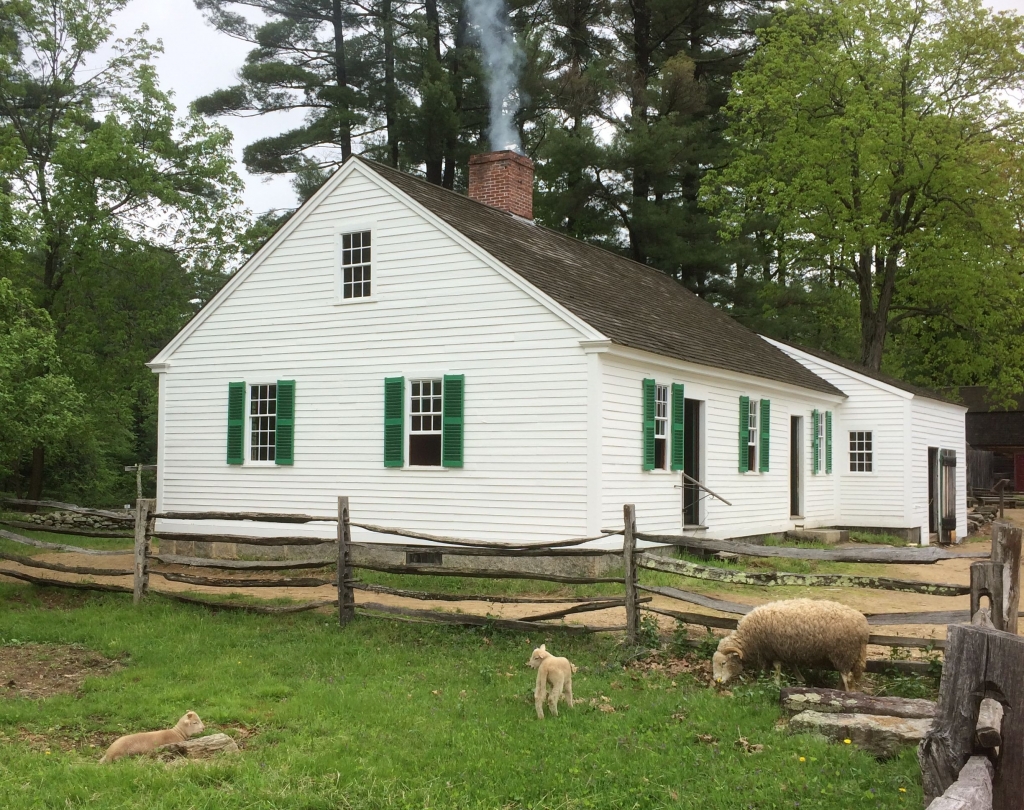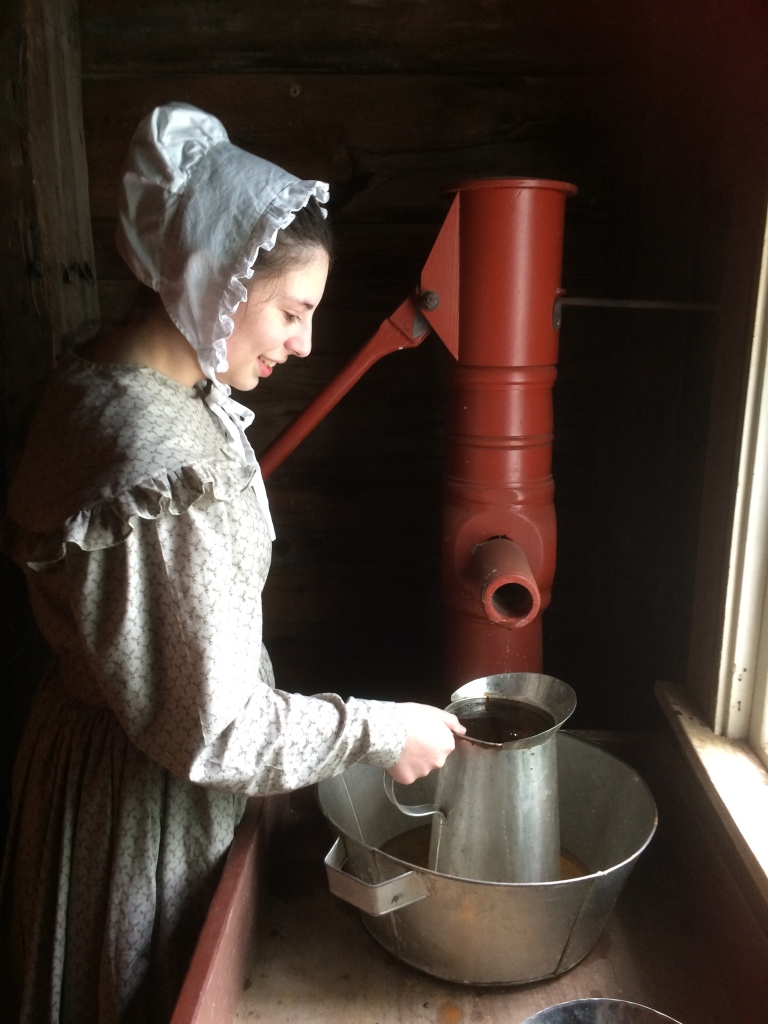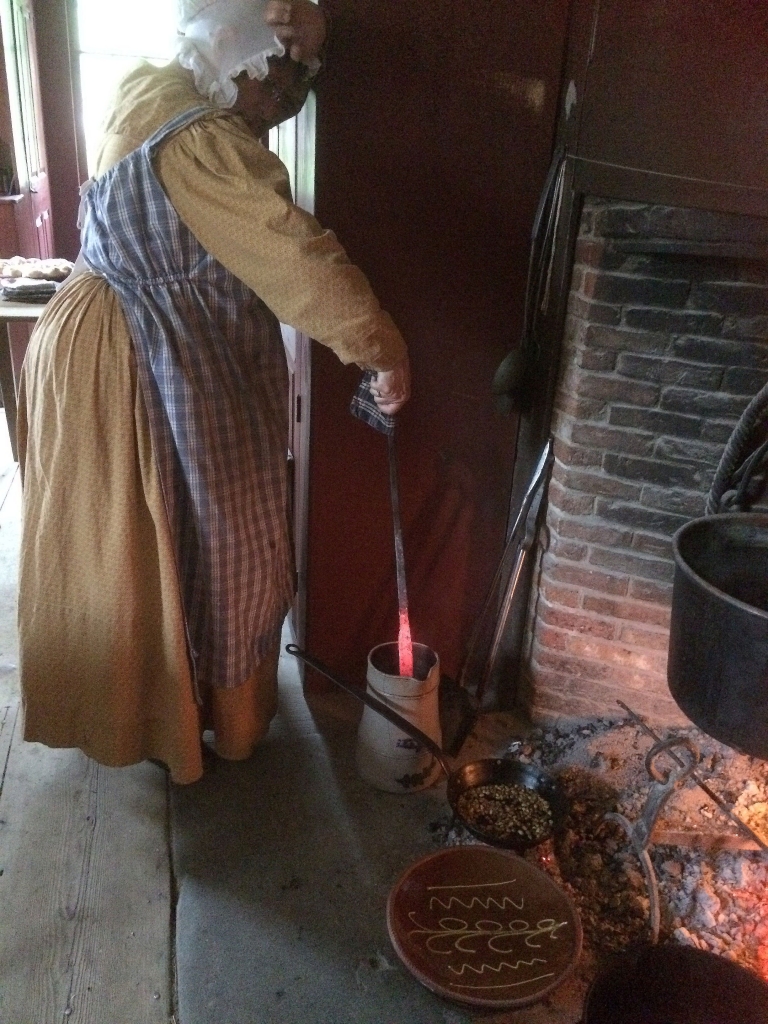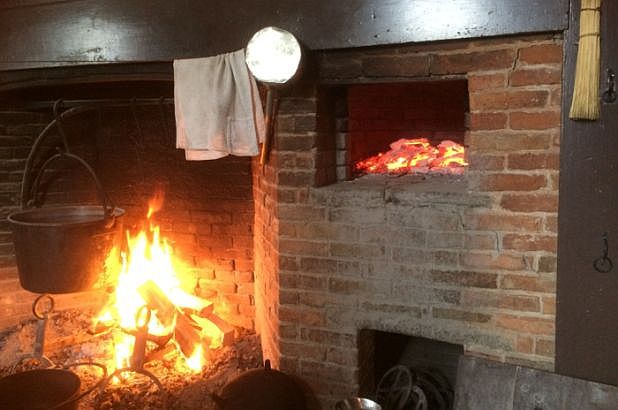If you frequent colonial-era house museums you will be quite familiar with seeing all manner of heavy cast iron pots, pans and tools crammed or clustered in kitchen fireplaces, sometimes sitting on iron ‘dogs’ on the floor of the fireplace or suspended from ‘cranes’ fitted into the brick work. But rarely do we see these seemingly rudimentary set-ups in operation in Australia, let alone get to actually prepare food on them.
The closest we probably get to experiencing hearth-side cooking is on camping trips, using billies or iron pots and Dutch ovens and perhaps spits to roast from. I recently visited Old Sturbridge Village Living History Museum, in Massachusetts, USA, to see hearth-side cookery and other practical crafts from the 1830s in action.

The Bixby’s cottage, Old Sturbridge Village, USA. Photo Jacqui Newling © Sydney Living Museums
Boarding at the Bixby’s
Along with all the interactive food and handicraft experiences at Old Sturbridge Village, the main incentive for my visit was to participate in a hands-on weekend program ‘Boarding with the Bixby’s’ to experience cooking in an 1830’s style kitchen. This special ‘sleepover’ program allows visitors to be ‘guests’ in an 1830s farmhouse, which was the home of blacksmith Emerson Bixby and his family, from 1826 until the 1870s. Under the supervision of two wonderful museum guides, six guests are apprenticed to a trade for two hours (I was assigned to the blacksmith’s forge), prepare the evening meal, eat it before sleeping the night on straw mattresses, attend to the morning chores (gather eggs, milk the cow) and cook up leftovers from last night’s dinner for breakfast. All this is done without electricity or running water in the house, pumping water into jugs and washing dishes in basins.

Pumping water in the Bixby’s house at Old Sturbridge Village museum. Photo Jacqui Newling © Sydney Living Museum
Multi-function cookery
My particular focus was on hearth-fire cookery techniques. Modern iron cooking ‘ranges’ were being introduced from the late 18th century, however a vast number of people cooked in open fireplaces, well into the 1800s. Generally they were fitted with iron rods suspended above the fire or ‘cranes’ that could be swung in and out for easier and safer access to the pots that hung from them. These cooking systems may seem rudimentary, but a skilled cook knew how to manage pots, pans, cauldrons and pokers and expose them to the right type of heat by positioning them in various parts of the fireplace. They were also very versatile, enabling multiple cooking techniques – boiling, stewing, frying, roasting, toasting – all at the same time, using different types of vessels and utensils.
The dinner menu
On the dinner menu was potted cheese with crackers, roasted lamb seasoned with kitchen pepper (an old favourite of The Cook & the Curator), served with mint sauce, ‘fricasee’ of parsnips (cooked in milk), boiled carrots and potatoes, rhubarb and apple pie, cheese and walk-up’ bread (similar to a scone-dough loaf).

Cooking in, on and before the fire. Photo Jacqui Newling © Sydney Living Museums
Before the fire
Old recipes often ask you to place something ‘before the fire’ which for modern cooks is a curious option. It means of course, cooking in front of the fire rather than on it, using radiant heat. For more gentle cooking pots and dishes could be placed in the area in front of the fire, sitting on the warm hearthstones, or if more heat was required, on trivets placed over small piles of coals scooped from the firebed. For dishes that required constant stirring – custard or a sauce that might stick, for example – this ‘satellite’ set-up saved the cook the discomfort of reaching into the fire itself, which was hot work and also unsafe. Saute pans could be purchased with legs attached specifically for this type of cooking, saving the need for trivets.

The dangle spit method of roasting meat ‘before the fire’ with a pot below to catch the drippings. Photo Jacqui Newling © Sydney Living Museums
Dangling about
Meat was roasted before the fire, on spits that were either built into the hearth-fire cooking system or attached to the mantle shelf. Wealthy households often in the 19th-century installed spits that turned automatically, either with a wind-up ‘jack’ mechanism or using a ‘smoke jack’ that used energy created by smoke drawn up into the chimney. Although less efficient, the dangle spit (shown above) was a cheaper option that any household could employ.
A skewer would be pushed through a haunch of meat or trussed poultry, and each end of the skewer then tied to two lengths of twine or cord, which are knotted at the top and fixed to the mantle, with the meat suspended in front of the fire. The strands were then carefully twisted, causing the meat to spin around as it unwound. This as quite an art – twisted too tightly the meat would spin too quickly, so the correct tension was required. For the meat to cook evenly the string would have to be re-twisted every few minutes and needed constant attention, and you can understand what a boon it must have been to have a mechanical apparatus. A pot was placed beneath the meat to catch any drippings and juices for gravy.

Mulling cider in the pot with a red-hot poker, heated in the fire. Photo Jacqui Newling © Sydney Living Museums
A red hot poker
Mulled cider was a popular hot drink, particularly in the winter months. Rather than using precious pot hanging space to heat the cider up it could be heated up in a jug as shown above using an iron poker. The poker was placed in the fire’s hot coals until red hot, then carefully dipped into the jug (you have to be careful as it spatters as it hisses and sizzles) and stirred through the cider until the heat is transferred from the rod into the cider. The cider can be left to keep warm until required.



